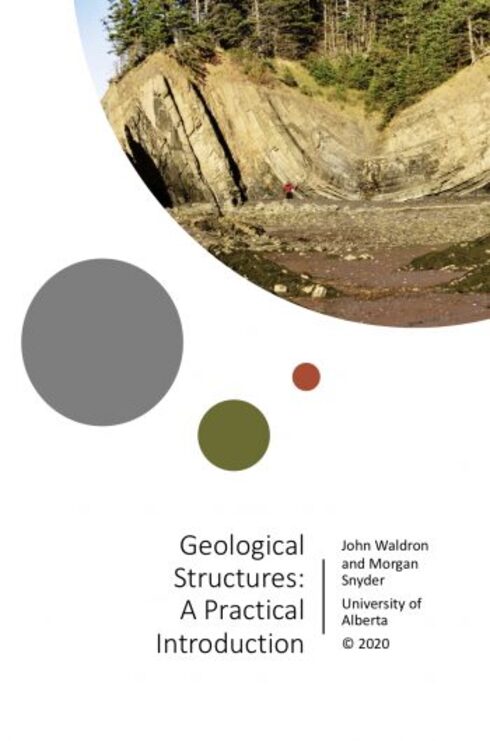
Geological Structures: a Practical Introduction
![]()
![]()
![]()
![]()
![]()
John Waldron, University of Alberta
Morgan Snyder, Acadia University
Copyright Year: 2020
ISBN 13: 9781551954424
Publisher: Open Education Alberta
Language: English
Formats Available
Conditions of Use
![]() Attribution-NonCommercial
Attribution-NonCommercial
CC BY-NC
Reviews
This books covers basic topics in Structural Geology with very good examples of material and processes to enhance comprehension. The book is missing a section focused solely on the behaviors of rocks when subjected to stress as a function of... read more
![]()
![]()
![]()
![]()
![]()
This books covers basic topics in Structural Geology with very good examples of material and processes to enhance comprehension. The book is missing a section focused solely on the behaviors of rocks when subjected to stress as a function of various environments factors. It would have been great to see a capstone chapter discussing the tectonic history a selected region in details. This type of chapter will provide readers with an opportunity to see the overall incorporation of separately discussed topics into one theme to buttress the interrelationships between the various topics.
Subjects in this book have been accurately presented and discussed without preferences and preconceptions.
This book starts with basic concepts, processes, and materials which represent the building block to understanding the behaviors of rocks when subjected to stress. These fundamental concepts are universal and applicable in advance structural geology. While online resources in the area of stereographic projection is mentioned, it would have been more beneficial if it had been elaborated on in greater details. This is because students are increasingly having to learn a great deal virtually, and are more dependent on various types of apps for learning activities.
Concepts, processes and materials have been succinctly presented and discussed throughout this book.
The terminologies, conventions and units used in this books are consistent and are maintained throughout.
The subsections within each section are not listed in the table of content, neither have they been listed at the beginning of sections. This presents a challenge for readers as they are unable to plan what to read without reading through the whole book or section. The subsections have also not been numbered, thereby presenting a difficulty to readers in organizing how and where to read or in locating particular subsections in the book.
The sections and subsections in this book follow a logical progression with each being very concise. However, a section discussing the responses of rocks to stress should have been included and discussed before the discussion on Folds.
The table of content is not elaborate and detailed enough to include subsections. The sections and subsections are not labeled appropriately, this presents navigational issues in locating topics without going through the whole book. A couple of images are also not very clear either due to the quality or resolution of the pictures used.
This is an easy to read book with the use of simple sentences and appropriate grammar.
This book is not culturally offensive and examples of geological formations and features have been presented from different parts of the world.
This is a well written book missing two important sections already pointed out. The table of content will benefit from the inclusion of subsections that are appropriately and sequentially labeled or numbered to enable easy navigation by readers. The laboratory exercises in this book of particular very useful in introducing students to techniques in structural geology.
Table of Contents
- A. Geological Structures
- B. Orientation of Structures
- C. Primary Structures
- D. Stereographic Projection
- E. Folds
- F. Boudinage
- G. Kinematic Analysis and Strain
- H. Fabrics
- I. Dynamic Analysis: Stress
- J. Fractures
- K. Faults
- I. Tectonic Environments of Faulting
- M. Shear Zones
- N. Extraterrestrial Impact Structures
Ancillary Material
Submit ancillary resourceAbout the Book
This manual is about structures that occur within the Earth’s crust. Structures are the features that allow geologists to figure out how parts of the Earth have changed position, orientation, size and shape over time. This work requires careful observation and measurements of features at the surface of the Earth, and deductions about what’s below the surface. The practical skills you will learn in this course form the foundation for much of what is known about the history of the Earth, and are important tools for exploring the subsurface. They are essential for Earth scientists of all kinds.
The course that this document supports is about doing structural geology. It’s not possible to be a good geologist (or to pass the course) just by learning facts. You have to be able to solve problems. Do your lab work conscientiously and get as much as possible done during lab sessions when instructors are available to help you.
This manual consists of both readings and lab exercises, which alternate through the text. The readings are designed to be read and understood outside the lab sessions, whereas the labs contain specific instructions and questions to be completed. Before each lab, be sure you have covered the readings that come immediately before it.
About the Contributors
Authors
John Waldron, University of Alberta
Morgan Snyder, Acadia University
